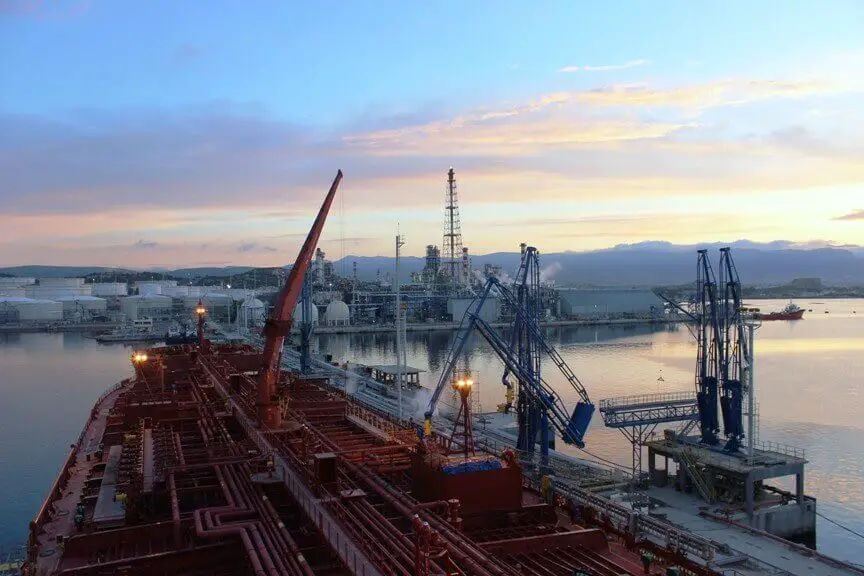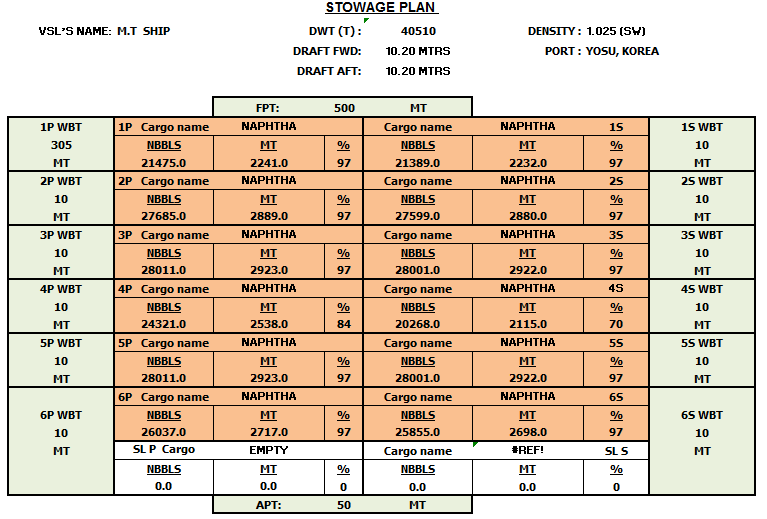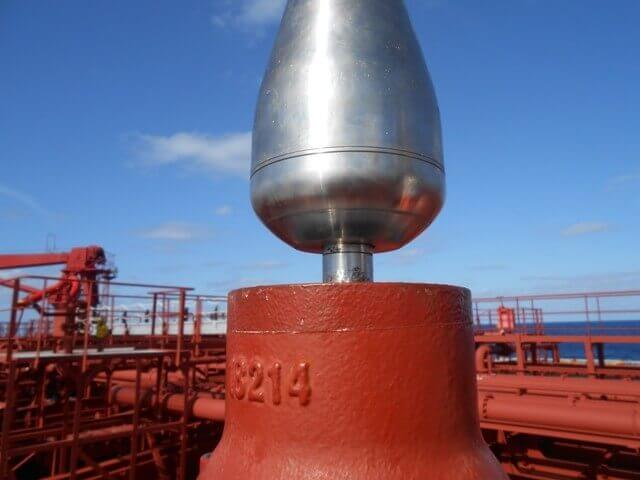Voyage Orders
The vessel will usually receive voyage orders from the Charterers which will contain the following information:-
- Ports of loading and discharge along with draft limitations (if any)
- Volume / Weight to be loaded, grade or grades and Densities involved
- Special requirements of cargo – e.g. heating
- Special properties of cargo – e.g. H2S
Planning Cargo Stowage
The following factors are to be considered when planning stowage of cargo as applicable:
- The limiting load line zone of the loaded passage and the port of destination.
- Draft restrictions during the voyage and at the load and discharge ports.
- Consumption on intended passage.
- The stress conditions should be within the permissible limits of the bending moments and sheer force for sea conditions.
- Sufficient volume for possible expansion of cargo on the intended voyage.
- Two valve segregation of cargo parcels where applicable.
- Distribution and sequence of multi-grade cargoes.
- The sequence of multi-port voyages.
- Trim for efficient discharge and draining of tanks.
- Crude oil washing and final stripping.
- Is the product included in the Certificate of Fitness.
- BCH/IBC Code (whichever applicable for carriage requirements).
- Handling/cleaning procedures.
- Pollution category (MARPOL).
- Coating resistance compatibility.
- Inhibitor requirement.
- Heating requirements.
- Boiling/freezing point for adjacent stowage.
- Maximum recommended adjacent temperature.
- If specific gravity is acceptable according to Certificate of Class
- Prewash requirements.
- Vapor return.
- Toxicity
Loading Plan
A detailed loading plan shall be prepared to contain the following as applicable:
- Names and quantities of the cargo/products to be loaded.
- Quantity to be loaded in each tank.
- The pipeline system to be used with each grade.
- The sequence in which products are to be received.
- The final ullage of each tank.
- Identification of all valves to be closed / opened.
- The loading rate.
- Stress/BM at various stages of loading.
- Drafts (and air drafts if terminal restrictions present) at various stages of loading.
- GM at various stages of loading.
- Ballast sequences in relation to loading.
- Depth available alongside at low water.
- Agreement with terminal regarding Vapour Recovery System settings ashore and onboard.
- Any special instructions
The Chief Officer, in consultation with the Master, shall prepare the vessel’s load plan. Information related to the vessels operation in port, e.g. cargo details, connection details, port operation characteristics, tide details, mooring arrangements, special port requirements, etc should be obtained from the Port Guidelines, Agents, etc, in good time. Similarly, ship specific requirements must also be intimated to the terminal, agents and/or charterer’s as required.
Tank Capacity
When cargo is to be lifted to full capacity, the tanks must not be loaded beyond 98% of their maximum capacity, having due regard to the possible expansion of the cargo.
The following shall be considered when loading to full capacity:-
- The temperature of cargo at load port.
- The ambient temperature at the load/discharge port and the expected air/sea temperature during the voyage.
- Cargo heating required during voyage/discharge.
- Multi-grades: – the possibility of heated cargo in adjacent tanks.
- Tanks with common boundaries with fuel oil tanks (mainly slop tanks) get heated up as the fuel oil is heated up. Sufficient ullage to be allowed for this.
Overloading
Vessel stability manual shall be referred to as maximum loading limitation with regards to the specific gravity of the cargoes.
The vessel shall at no time be loaded beyond the relevant load line mark. The Master and Chief Officer shall ensure that cargo calculations must allow for water density, limiting drafts over bars/channels/canals, steaming time on long river transits, and squat.
The load line regulations apply to the midship marks. A laden tanker tends to sag and hence while the draft fore and aft may be within permissible limits, the vessel may be considered to be overloaded due to the midship draft.
Loading Rate
Loading of cargo tanks with petroleum chemical products or ballast must always be commenced at a slow rate. Once the flow has been established and into the correct tanks, the loading rate may be increased to the agreed figure.
The loading rate shall be decided based on the following: –
- Pipeline / Valve size and the design of the pipeline system.
- Number of tanks being loaded.
- The possibility of static accumulation (especially static accumulator cargoes).
- The possibility of water or air in shore line’s increasing electrostatic hazards.
- Cargo temperature (thermal shock to steel work).
- Topping up rate and prevention of hydraulic shock to ship and shore line’s when closing valves during completion of loading.
- The venting capacity of P/V valves or Mast Riser.
- Number of portable gauging equipment’s onboard.
In order to guard against the possibility of the tank over pressurization, it is essential that loading rates be kept in accordance with the tank venting arrangements. It must be noted that the maximum permissible loading rate will also be governed by the nature of the cargo to be loaded.
Free Surface Effect
To reduce free surface effects and sloshing stress on the vessel, it is desirable that tanks are loaded full (98%), leaving a minimum number of slack tanks. When tanks have to be left slack, the volume in the slack tanks should be calculated so as to safely remain within the sloshing limits prescribed for the vessel.
‘Sloshing’ is the movement of liquid within a hold when the ship is rolling or pitching. It can give rise to:
- Structural damage caused by the slamming effect of the liquid against the tank structure.
- Damage to heating coils and cargo pump especially during small quantities including tank washings.
- An electrically charged mist in the ullage space of tanks partially filled with a mixture of oil and water, such as dirty ballast or tank washings. This can even occur with only a slight rolling motion.
In order to eliminate these problems, slack tanks must be avoided wherever possible.
Ship Shore Safety Checklist
The ship-shore safety checklist as per International Safety Guide for Oil Tankers and Terminals (ISGOTT) shall be completed after physically checking that all items applicable to the vessel are complied with.This checklist shall be completed in co-ordination with the terminal representative.
Tank Inspection
The ship is responsible for maintaining the cargo quality once it has been loaded. Tank inspection is, therefore, one of the most important tasks personnel and done by independent inspectors. The inspection requirements and methods vary according to the quality of the product to be loaded and the cargo or cargoes contained in the same tank or tanks during previous voyages.
Prior to loading, the vessel’s tanks are inspected by the terminal representative and / or surveyor(s), who should sign a certificate as applicable, indicating the amount of sediment, oil and free water remaining in the tanks prior loading as applicable.
PV Valves Setting
With reference to SIRE VIQ please note the following;
In the case of inerted vessels, if pressure sensors are provided as the means of secondary protection, the alarm settings for the pressure sensors must be set to actuate when the tank pressure reaches 10% greater than the normal actuation settings of the pressure valves themselves. In the case of the low-pressure settings, the pressure in a tank should never be permitted to fall below zero and the pressure sensors should be set to alarm above zero.
In the case of non-inerted vessels if pressure sensors are provided, the over-pressure setting should be set to alarm at 10% greater than the normal actuation settings of the pressure valves, and at a vacuum 10% greater than the normal actuation settings of the vacuum valves.
Line Up
All concerned personnel shall be aware of the lineup to be used. Once the sequence of loading has been agreed to, the pipelines and valves shall be set for loading. Vessels fitted with drop lines for loading should use those lines for receiving cargo, bypassing the pump room.
Valves not in use, both in the pump room and on deck shall be firmly closed and where required, lashed. Where valves are operated from the Cargo control room or a deck junction box, suitable indication shall be provided to prevent accidental operation.
The manifold lines, not in use, are to be blanked with all bolts in place and tight. The position of all main, stripping, tank and pump room valves must be checked to ensure that those valves, which are to be shut, are in fact closed.
The High level and High-High Level alarms systems shall be kept operational at all times during cargo operations.
Pre-Loading Meeting
A pre-loading meeting shall be carried out. The loading plan along with any relevant topic with reference to the upcoming loading operation shall be discussed with all the concerned personnel. They shall be provided with necessary information and instructions for carrying out their duties and responsibilities.
Above concludes the Pre-Loading basic procedures and guidelines.



Molestiae illum et dolorem placeat consequat Ullamco delectus quam ullam accusantium aut quam rem atque a in